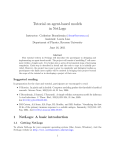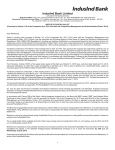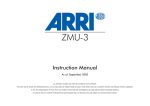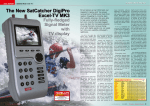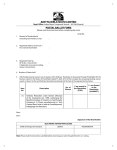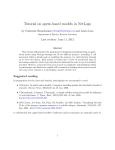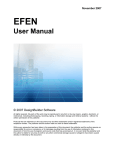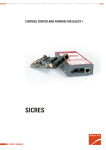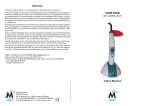Download Protection system maintenance and benefits of
Transcript
Protection system maintenance and benefits of standardized testing procedures Eugenio Carvalheira, OMICRON, USA Cord Mempel, OMICRON, Austria Abstract -- This paper discusses some challenges faced by electrical distribution utilities in the maintenance of their protection system assets. In order to set a proper and efficient maintenance program two important aspects should be taken in consideration: have a system in place to manage and document maintenance activities and establish standardized protective relay testing procedures. This paper presents a solution that can be used to overcome these challenges. Index Terms – Protection Systems, Standardized Test Templates, Maintenance Management I. INTRODUCTION Protection system components play a vital role in the reliability of the power system. Each component involved shall be tested and maintained in a timely manner according to the applicable industry or company standards. This is essential to ensure proper operation of the system, to keep it in good working condition and to maximize the power system’s reliability and availability. The electrical distribution utilities have been facing several challenges to accomplish the task of keeping the system well maintained and reliable. New regulatory requirements, pressure to reduce costs, lack of personnel and increasing complexity of the system are some of the challenges they have to deal with. An additional challenge faced is the technological evolution of the system, as for example of the protective relays. Relays have evolved from electromechanical to multifunctional numerical technology. The way how protective relay testing is done has been changing over the years due to this technological evolution. Ten to twenty years ago the tests were performed by the testing personnel almost manually. The relay test quantities were hand calculated and a passive test set (comprised of resistive loads, mechanical phase shifters and variable autotransformers) was manually operated. The operating characteristics of electromechanical relays were shaped by resistor, inductor and capacitor networks while springs and levers defined the operating times. A small number of parameters had to be checked. For documentation of test results, these small number of measured parameters were entered manually in a test protocol, signed by the test personal and archived. With the appearance of modern multifunctional numerical relays the number of parameters and the complexity of protection functions have increased drastically. The protection relay has incorporated a lot of control and automation tasks. Programmable logic is used for building protection schemes. Deep knowledge about the relay algorithms, functions and logics are required for testing [3]. The number of test results to be documented have increased as well. To overcome such challenges, utilities need to use appropriate testing and database maintenance tools. Nowadays modern test equipment include electronically regulated voltage and current sources that provide the accuracy and the output power required to test all components of the system. Ease of use test equipment software provide the capability to run automated tests controlled by computer software [2]. This allows the realization of more sophisticated tests. The use of pre-defined standardized test plans is essential for an efficient maintenance program and to increase traceability and reproducibility of testing. A user-friendly database management system is also of great importance for storing the standard test plans, keeping track of all maintenance activities and managing documentation of test results in a central place. II. STANDARDIZED TEST PLANS As the complexity of protective relays has risen, the need for standardization increased. By establishing their own standard testing procedures, that meet company specifications, the electrical utilities have a lot of additional benefits: - Save time of protection engineers on developing a test - Testing quality can be better controlled and improved - Working together as a team is easier, as everyone uses the same test plan and the same test protocol - Company know-how can be added to the standard and gets automatically documented The user should define two levels of standardization. First a standard on how to test dedicated protection functions and then a standard on how to test specific protection applications (e.g. line or transformer protection). An example is the standardization of the test for a transformer differential protection function. A standard procedure may be: 1 - Configuration or stabilisation test (blocking for external faults) - Pickup test - Operating characteristic test - Trip time test - Harmonics blocking test The standard should also include the fault loops and transformer sides to be tested. Moreover, the number and position of test shots have to be defined. In additional to the "How to test", some general points can be added like safety procedures. The development of a testing standard and consequent definition of testing practices strongly depends on two different factors: the testing philosophy of the company and the type of test that will be performed. The requirements are different for test plans that will be used in type or factory acceptance tests, in commissioning tests or in routine maintenance activities. Independent of the testing philosophy used, protection engineers should have in mind some testing tool requirements they need as basis for designing new testing standards. A. Testing tool requirements The test standard defined by the utility can be documented as a preconfigured test plan. It can be defined for specific relay types or specific applications. These standard test plans should contain information about the relay under test, its setting parameters, how to test each protection function and schemes, instruction on test connections, safety instructions and recovery post-test instructions. The protection engineer should be able to get all this information and tests combined in a unique overall document as shown in ¡Error! No se encuentra el origen de la referencia.. After performing the test he should be able to easily generate a test report for documenting the test. Picture 1 disabling protection functions or changing the route of information to binary outputs should be avoided. It ensures not only individual functions will be tested but the overall scheme and the influences one function may cause on another. In order to accomplish these challenges, the testing tools should meet some basic requirements: - Free-configurable test templates with reporting - Relay models are available - Automated test and assessment based on relay settings - Ability to incorporate instructions to the test document (text, pictures, files) - Static simulations - Transient simulations for testing under close to realistic conditions (e.g. Power Swing simulations) Depending on the application and technology used, the advanced testing tools should meet further requirements, like: - Searching test of distance and differential characteristics - Overall overcurrent characteristic depending on the fault type - Testing with IEC 61850 GOOSE and Sampled Values messages - Real simulation of CT saturation - Simulation of Power Quality phenomena B. Relay Models A relay model should contain a place to enter the specific relay setting parameters. Based on these specific settings, the relay is modeled and represented within a common representation independent of manufacturer. As result of these modeling all protection characteristics are built up and test parameters are calculated. The user does not have to always re-think how to test the relay, but all he needs to do is enter the relay settings and all the test will be filled out automatically. The concept of the relay models and automatically calculation of characteristics based on the relay settings is shown in Picture 2. Example of a Test Document A very important target should be testing the relay under its operational conditions. That means, the relay should be tested without having its settings or configuration changed for the test. Modifications like 2 tance characteristic already available from the relay modeling, the addition of the new test is simplified. Picture 3 Picture 2 Relay Model Concept After the protection engineer has parameterized the relay under test using the relay software, he enters the relay settings in the test tool. Ideally, the user has to enter the relay settings in the same structure as in the relay manufacturer software. It can be done manually or using automatic import functionality, in case the relay software provides an export of them. The relay characteristics are automatically calculated at the given parameterization. C. Example of a Standardized Testing Procedure: Test Plan for a Schweitzer SEL-421 In this chapter an example is shown on how a utility made use of a given testing template and adapted it to create their own test standard meeting their requirements. The given template is part of the Protection Testing Library (PTL) provided by OMICRON [4]. The utility had specified that the test of auto reclose function (ANSI 79) should be included in the test plans for the SEL 421 distance relays. The protection functions covered by the existing template in the OMICRON library are [4]: - 21 Phase/Ground Distance protection - 50/67P Phase Instantaneous Overcurrent - 50/67G Residual Ground Inst. Overcurrent - 50/67Q Negative Sequence Inst. Overcurrent - 51 Time Overcurrent First of all, the Hardware Configuration of the test set should be checked to see if all necessary signals are available for the test. For testing of the auto reclose function, the close command signal from the relay is needed to evaluate the function's closing time. One option for this test is to create a sequence of states to simulate a successful auto reclose cycle. The states necessary to simulate a 1-shot re-closure are: - Pre-Fault: simulates a nominal load condition; it should be run for a time enough to guarantee the auto reclose function goes to a reset stage. - Fault: simulates a Zone 1 trip condition. This state is triggered by the trip signal. - Pole open interval: circuit breaker opened condition; during this state the close command is expected from the relay, that will trigger the sequence to jump to next state. - Successful reclose: nominal load condition after the circuit breaker has been closed. The time between the circuit breaker opening and the receiving of the close command signal can be measured and automatically assessed. Picture 4 It is important to mention that the user may rearrange the complete test template, change the predefined test points or delete test modules if the test strategy does not fit his demands. According to the list above, testing of the auto reclose function is not included. However, the user can find the complete relay settings, even the settings related to functions which are not supported (see Picture 3). With the necessary data and also the dis- Reclosing settings in the testing tool Sequence of States and automatic update of parameters All the necessary testing parameters can be automatically set in the sequence linking them to the relay settings part, as illustrated in Picture 4. These links are done to the relay settings that are already available in the relay model. The definition of the fault condition (State 2) is very easy since the distance characteristic is already modeled. It is only necessary to define the fault location relative to Zone 1 impedance. 3 Picture 5 Detail and Impedance View of Fault state The new created modules can be added to the test template. The user can configure the module to be enabled only if the reclosing function is enabled at the specific site by using the linking functionality. If desired, other modules can be added to test the auto reclose function when it is used with two or more numbers of re-closure cycles. Picture 6 right up to date test plan, populates it with the proper relay settings and has easy access to additional instructions and documentation. There are several software tools on the market addressing these needs. Many of them offer additional features and benefits, however many such tools are not very user friendly and require extensive training to use them. Some tools are not very helpful when utilities have to provide evidence on maintenance and corrective actions done (e.g. when a maloperation has occurred or for an audit). It is important for a maintenance management tool to include not only protective relays but also all other components that form the protection system: - Communications systems necessary for correct operation of protective functions - Voltage and current sensing devices providing inputs to protective relays - Station dc supply associated with protective functions (including station batteries, battery chargers, and non-battery-based dc supply) - Control circuitry associated with protective functions through the trip coil(s) of the circuit breakers or other interrupting devices SEL 421 template with new Auto-Reclose tests As the given SEL 421 template supports the import of relay settings, the new integrated tests of the auto reclose function can also make use of this feature. Changed relay settings will be updated immediately in all test modules of the test plan. III. MAINTENANCE MANAGEMENT Due to large number of components involved in the protection system, management maintenance activities and proper documentation of test results may become very complex. A. Requirements for a maintenance management tool Utilities may need a tracking tool to help schedule the maintenance activities for all protection system components, and to store all the documentation of such activities. Tool support is also essential for the protection tester in the field: he should get support to select the Picture 7 Typical protection system (indicating possible error sources that can lead to relay maloperation) Correct functioning of all components of the protection system is required to securely clear a network fault. Picture 7 shows a typical protection system with possible sources of errors. Therefore the whole system should be considered during maintenance. B. ADMO - A database solution for protection system maintenance Even with automated test plans and excellent testing tools, testing and maintenance of the protection system is a challenging task. Therefore ADMO has been specially designed to support this task and to provide the most intuitive and easy to use solution possible. Key features are: - Support protection testing at site 4 - Easy and intuitive document management of the protection system - Easy and intuitive management of test documents - Planning and management of maintenance activities The ADMO main screen (Picture 8) provides the maintenance status overview: - For all components of the protection system - For a certain location (e.g. a substation) - For components matching a filter condition (e.g. for a certain type, a responsible person etc.) In this overview the yellow bar shows all devices due for maintenance, the red bar the devices already overdue and the magenta bar devices where data is incomplete. Picture 8 Overview of maintenance status of the overall system at a glance with ADMO Once a specific asset is selected, ADMO shows the maintenance history of this relay. The user sees when the next maintenance is due or overdue and gets direct access to test documents when clicking on the related maintenance event (Picture 9). Picture 9 Asset maintenance history and test documentation for the last maintenance in ADMO C. Supporting protection testing Using standardized and automated test plans (as described earlier) already supports the tester a lot: - The test procedure (test points) is already defined - The test plan includes instructions and gives guidance for the tester - The test plan adapts automatically to the relay settings - The test steps and the relay settings are included in the test document ensuring traceability and repeatability - The test report is generated automatically ADMO complements the testing software as follows: - When the tester starts testing (creates a maintenance event in ADMO), ADMO provides him all test plans suitable for this relay type - In addition ADMO provides easy access to other documents related to this relay type or location (e.g. relay manual, cubicle drawings, substation information) - After selecting the test plan the tester can directly start the testing software from ADMO - Before starting to test the tester needs to load relay settings into the test plan. ADMO provides direct access to import of setting files assigned to the tested relay - The tester can add additional information and files to document actions done (or problems occurred and solved) - Test results are stored back automatically in ADMO and can be synchronized with the central database later - In case of unclear protection behavior ADMO allows access to other test documents (comparison with other relays tested) - ADMO allows definition of follow-up activities and shows the test status (e.g. if the final assessment should be done later in the office (Picture 10) Picture 10 Maintenance event with test document, final Event Status still open D. Regulatory Compliance in North America and NERC PRC-005 In North America (USA and parts of Canada), there is an independent non-profit organization that is 5 responsible for monitoring the maintenance and security practices of the Bulk Electrical System; this entity is known as the North American Electric Reliability Corporation or NERC. NERC was formed in 1968 by the electric utility industry as a response to a major blackout which occurred in the Northeast of the United States in 1965. NERC PRC-005 is the standard for “Protection System Maintenance” defining required maintenance activities and minimum intervals for the protection system. It enforces utilities in North America to have a documented protection system maintenance plan and to provide evidence on all maintenance activities. Noncompliance with NERC standard can lead to heavy fines. Intended to ensure the reliability of the bulk electric power system this standard mainly applies to generation and transmission, however it is influencing maintenance in distribution systems as well. IV. CONCLUSION The definition of standard testing procedures and the use of a database maintenance management tool are very important things electrical utilities may do in order to establish an efficient maintenance program. The protection functions of modern numerical relays are more complicated than in the older ones and the complexity of functions is increasing with every new relay version. For this reason testing standardization is getting more important. The traceability and the reproducibility are important factors for an efficient work. The paper illustrated that with a solid base and making use of proper testing tools it is possible to build standard test plans with a minimum effort. In addition to the standard test plans, a userfriendly database system helps the protection group at utilities to track their maintenance activities. The paper illustrated how such a database system can be used for archiving the standard test plans (to be used in future maintenance events), for managing the maintenance of all components of the system according to established time intervals and for documenting the test results. [4] SEL-421 Distance Protection Test Template User Manual. OMICRON electronics, 2014 [5] R. Bhandari, C. Mempel, B. Jenkins. Protection System Maintenance: Test, Maintain, and Comply with NERC Reliability Standards. International Protection Testing Symposium 2013, USA [6] Track it or lose it, ADMO – the new NERC PRC-005 compliant database solution for protection systems. OMICRON Magazine, page 26, Volume 3 Issue 2 2012 VI. BIOGRAPHIES Eugenio Carvalheira received his BSc in Electrical Engineering from the Federal University of Pernambuco, Brazil, and his MSc in Computational Engineering from the University of Erlangen-Nuremberg, Germany. He started his career as a Project Engineer responsible for the design, implementation and commissioning of protection and control systems for electrical substations and power plants. In 2008, he joined OMICRON electronics Germany as Training and Application Engineer designing and developing test automation solutions for protection relays and responsible for the IEC 61850 training courses of OMICRON. He is presently Regional Application Specialist and Training Manager for Latin America with OMICRON electronics Corp. USA in Houston, TX. Cord Mempel received his Diploma in Electrical Engineering at the Technical University of Braunschweig, Germany. He started his career at Siemens Berlin in development of numerical protection relays. This was then followed by further positions at Siemens in Nuremberg, including sales and project management for machine protection and then business development for Siemens protective equipment in the Middle East and Africa. In 2004, he joined OMICRON in Klaus, Austria. He is working in product management in the field of power system protection testing with a focus in data management solutions. Cord is a member of the IEEE PES and the German VDE. V. LITERATURE [1] OMICRON PTL User Manual (Protection Testing Library). OMICRON electronics, 2014 [2] A Survey of Relaying Test Practices. IEEE Power Systems Relaying Committee Report, January 2002 [3] B. Bastigkeit. How a library of Relay Specific Test Templates Can Support the Protection Engineer. International Protection Testing Symposium 2007, Austria 6







